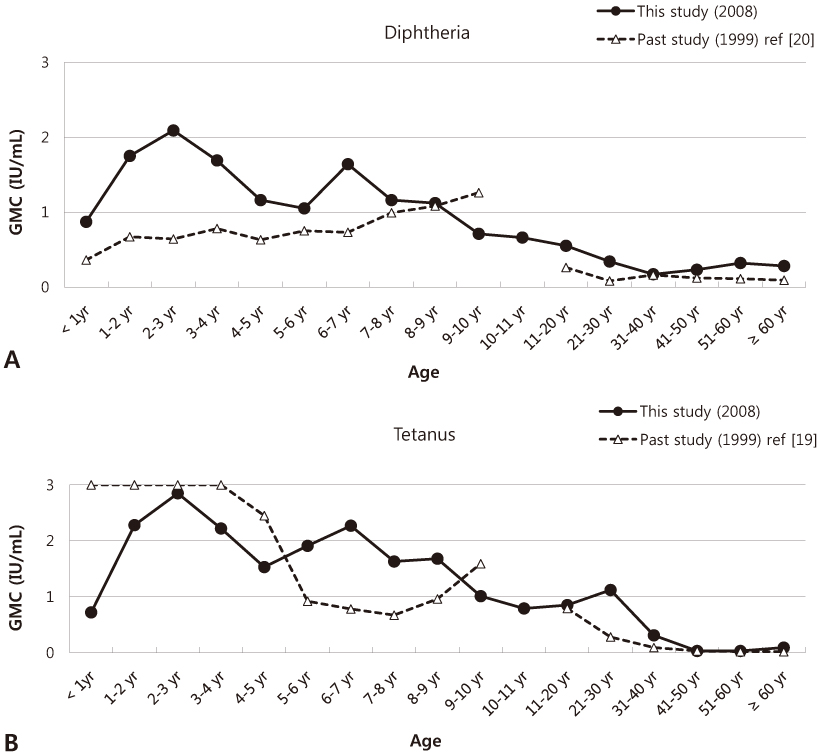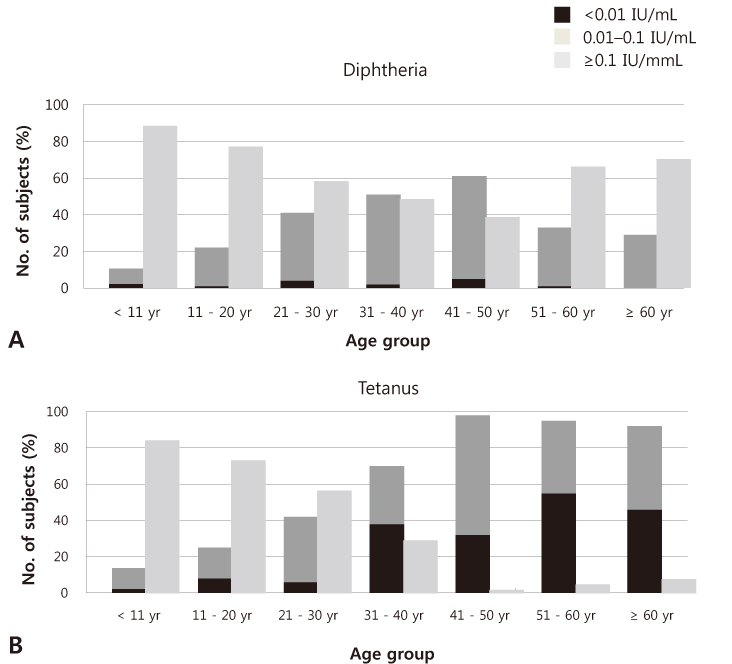Infect Chemother.
2012 Apr;44(2):62-66. 10.3947/ic.2012.44.2.62.
Immunoassay of Diphtheria and Tetanus according to Ages
- Affiliations
-
- 1Department of Pediatrics, The Catholic University of Korea, Seoul, Korea. kjhan@catholic.ac.kr
- 2Department of Internal Medicine, The Catholic University of Korea, Seoul, Korea.
- 3Department of Pediatrics, Changwon Fatima Hospital, Changwon, Korea.
- 4Department of Pediatrics, Soon Cheon Hyang University, Cheonan, Korea.
- 5Department of Pediatrics, Wonju Yonsei University, Wonju, Korea.
- KMID: 2054437
- DOI: http://doi.org/10.3947/ic.2012.44.2.62
Abstract
- BACKGROUND
The objective of this study was to evaluate protective immunity against diphtheria and tetanus in the Korean population.
MATERIALS AND METHODS
Healthy subjects were enrolled at four university hospitals in Korea. Subjects were assigned to seven age groups (every 10 years). Enzyme linked immunosorbent assay (ELISA) kits were used for measurement of diphtheria or tetanus anti-toxoid antibodies in sera, and geometric mean concentrations (GMC) of antibodies were determined. Subjects with antibody titers <0.1 IU/mL would require a booster vaccination.
RESULTS
A total of 1,605 subjects participated in this study. In analysis of antibody against diphtheria, subjects in the age group <11 yr showed the highest GMC (1.31 IU/mL) while the lowest GMC was observed in subjects in the 31-40 yr age group (0.17 IU/mL). With regard to tetanus, subjects in the age group <11 yr also showed the highest GMC (1.81 IU/mL). Among subjects > or =11 yr (600 subjects), 363 (60.5%) would require a diphtheria booster, and 422 (70.4%) would require a tetanus booster.
CONCLUSIONS
GMC of antibodies against diphtheria and tetanus of adolescents and adults were relatively low, while those of children in Korea were satisfactory. Approximately two-thirds of Korean adolescent and adult subjects in this study would require a booster vaccination in order to maintain long-term protective immunity against diphtheria and tetanus.
Keyword
MeSH Terms
Figure
Cited by 3 articles
-
Vaccines of Our Own
Jin-Hong Yoo
J Korean Med Sci. 2019;34(4):. doi: 10.3346/jkms.2019.34.e33.A Phase III Study to Evaluate the Immunogenicity and Safety of GC1107 (Adult Tetanus Diphtheria Vaccine) in Healthy Adults
Jacob Lee, Jung-Hyun Choi, Seong-Heon Wie, Sun Hee Park, Su-Mi Choi, Mi Suk Lee, Tae Hyong Kim, Hyo-Jin Lee, Jin Han Kang
J Korean Med Sci. 2019;34(4):. doi: 10.3346/jkms.2019.34.e31.A Case of Adult Membranous Croup Caused by Methicillin-Resistant Staphylococcus Aureus Mimicking Laryngeal Diphtheria
Chanhyeon Park, Dong Hoo Lee, Sung Yool Park, Do Hun Kim
Korean J Otorhinolaryngol-Head Neck Surg. 2020;63(5):233-237. doi: 10.3342/kjorl-hns.2019.00836.
Reference
-
1. Vetter RT, Johnson GM. Vaccination update. Diphtheria, tetanus, pertussis, mumps, rubella, measles. Postgrad Med. 1995. 98:133–137. 141–142. 144–145.2. Prevots R, Sutter RW, Strebel PM, Cochi SL, Hadler S. Tetanus surveillance--United States, 1989-1990. MMWR CDC Surveill Summ. 1992. 41:1–9.3. Gergen PJ, McQuillan GM, Kiely M, Ezzati-Rice TM, Sutter RW, Virella G. A population-based serologic survey of immunity to tetanus in the United States. N Engl J Med. 1995. 332:761–766.
Article4. . Expanded programme on immunization. Outbreak of diphtheria, update. Wkly Epidemiol Rec. 1993. 68:134–140.5. Hardy IR, Dittmann S, Sutter RW. Current situation and control strategies for resurgence of diphtheria in newly independent states of the former Soviet Union. Lancet. 1996. 347:1739–1744.
Article6. The Korean Pediatric Society. Lee HJ, editor. Diphtheria, pertussis, tetanus vaccines. Immunization guideline. 2008. 6th ed. Seoul: The Korean Pediatric Society;75–90.7. Maple PA, Efstratiou A, George RC, Andrews NJ, Sesardic D. Diphtheria immunity in UK blood donors. Lancet. 1995. 345:963–965.
Article8. IPSEN J Jr. Immunization of adults against diphtheria and tetanus. N Engl J Med. 1954. 251:459–466.
Article9. Galazka AM, Robertson SE. Immunization against diphtheria with special emphasis on immunization of adults. Vaccine. 1996. 14:845–857.
Article10. Sesardic D, Corbel MJ. Testing for neutralising potential of serum antibodies to tetanus and diphtheria toxin. Lancet. 1992. 340:737–738.
Article11. Christenson B, Böttiger M. Serological immunity to diphtheria in Sweden in 1978 and 1984. Scand J Infect Dis. 1986. 18:227–233.
Article12. Khuri-Bulos N, Hamzah Y, Sammerrai SM, Shehabi A, Hamed R, Arnaout MA, Turk J, Qubain H. The changing epidemiology of diphtheria in Jordan. Bull World Health Organ. 1988. 66:65–68.13. Cellesi C, Zanchi A, Michelangeli C, Giovannoni F, Sansoni A, Rossolini GM. Immunity to diphtheria in a sample of adult population from central Italy. Vaccine. 1989. 7:417–420.
Article14. Vitek CR, Wharton M. Plotkin SA, Orenstein WA, Offit PA, editors. Diphtheria toxoid. Vaccines. 2008. 5th ed. Philadelphia: WB Saunders Co.;139–156.
Article15. Wassilak SGF, Roper MH, Kretsinger K, Orenstein WA. Plotkin SA, Orenstein WA, Offit PA, editors. Tetanus toxoid. Vaccines. 2008. 5th ed. Philadelphia: WB Saunders Co.;805–840.
Article16. Gergen PJ, McQuillan GM, Kiely M, Ezzati-Rice TM, Sutter RW, Virella G. A population-based serologic survey of immunity to tetanus in the United States. N Engl J Med. 1995. 332:761–766.
Article17. Stark K, Schönfeld C, Barg J, Molz B, Vornwald A, Bienzle U. Seroprevalence and determinants of diphtheria, tetanus and poliomyelitis antibodies among adults in Berlin, Germany. Vaccine. 1999. 17:844–850.
Article18. Reported tetanus in Korea. Korea Centers for Disease Control and Prevention (KCDC). Accessed 10 December 2011. Available at: http://cdc.go.kr/kcdchome/jsp/observation/stat/tot/STATTOT0902List.jsp.19. Kang JH, Hur JK, Kim JH, Lee KI, Park SE, Ma SH, Lee MS, Ban SJ, Hong SH, Cho DH, Lee SH. Age related serosurvey of immunity to tetanus in Korean populations. Korean J Infect Dis. 2001. 33:104–111.20. Kang JH, Hur JK, Kim JH, Lee KI, Park SE, Ma SH, Lee MS, Baek SY, Hong SH, Min HK. Age related seroepidemiological study of diphtheria among Koreans. Korean J Infect Dis. 2000. 32:1–7.21. Lee BK, Park JK, Yoo JI, Shin KH, Sohn YM, Park KD, Lee CG, Kim JS. Serological immunity to diphtheria among Korean population. Korean J Infect Dis. 1998. 30:278–283.22. Christenson B, Böttiger M. Serological immunity to diphtheria in Sweden in 1978 and 1984. Scand J Infect Dis. 1986. 18:227–233.
Article23. Galazka A, Keja J. Diphtheria: incidence trends and age-wise changes of immunity. Scand J Infect Dis. 1988. 20:355–356.
Article24. Ramsay ME, Corbel MJ, Redhead K, Ashworth LA, Begg NT. Persistence of antibody after accelerated immunisation with diphtheria/tetanus/pertussis vaccine. BMJ. 1991. 302:1489–1491.
Article
- Full Text Links
- Actions
-
Cited
- CITED
-
- Close
- Share
- Similar articles
-
- Antltoxln response to diphtheria and tetananus vaccine
- The Need of Td Vaccination According to the Changes of Tetanus and Diphtheria Immunity
- Tetanus–diphtheria–acellular pertussis vaccination for adults: an update
- Rates of Adverse Reactions Associated with Modified DPT Vaccine in Korean Infants and Children
- New DTaP Vaccine



